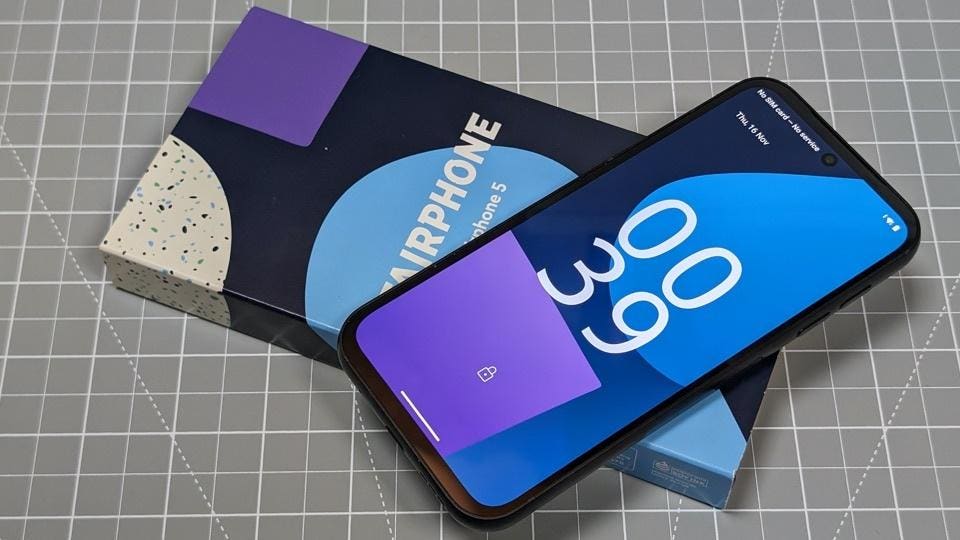With its latest smartphone, Amsterdam-based Fairphone continues its push to show how the electronics industry can be a fairer place by demonstrating its principles with a series of smartphones. The latest is the Fairphone 5, which illustrates this through repairability and the use of sustainable materials.
Fairphone as a whole, and the Fairphone 5 in particular, targets these areas with varying degrees of success. How you feel about the Fairphone 5 will come down to how you think about the longevity of a device, the resources used in manufacturing, and the phone itself.
Repairability and Longevity
The right-to-repair movement should see Fairphone as an example to all. Not only does Fairphone make the parts readily available to buy from its website (and other sites such as iFixit), but it has also designed the phone to allow someone at home with little technological knowledge to replace parts. Much of this is down to the modular approach—you don’t replace the camera sensor; you replace the camera module with its smaller circuit board holding all the connectors, sensors and lenses. It’s a nice balance point and not ridiculously expensive – a new camera module costs $75, while a new display costs $110.
Will the parts still be available in five to ten years? That’s hard to say, but looking at Fairphone’s web store, you can see parts for 2015’s Fairphone 2 still in stock. Along with the commitment to eight years of software support, the promise of spare parts is backed up by history.
Fairtrade Materials
Part of Fairphone’s approach is using recycled and sustainably sourced materials as much as possible. Recycled materials can be found in the plastics, the solder, the steel, and the alloys used in manufacturing the phone. Fair-trade gold is used where required, and cobalt and silver sources support the working conditions.
Fairphone releases impact reports to show its work with materials and in projects around manufacturing, such as renewable energy usage, reducing CO2 emissions, and e-waste recycling.
The Phone
None of this matters if the phone does not make an impact, both on individuals and the wider smartphone industry. As with previous models, one of Fairphone’s limiting factors is that they do not have as much buying power as more prominent manufacturers with smartphone production runs that are magnitudes larger than that of the Fairphone 5.
Couple that with the requirements for replaceable parts, limiting how much can be “off the shelf”, and the Fairphone 5 can be seen as a handset that is a bit more expensive than those with comparable specifications or a handset that is not as powerful as similarly-priced competitors. This consumer premium is balanced by the background decisions made by the company. Still, many will skip over the extra cost if the sustainability and fair-trade elements are not communicated clearly.
The Fairphone 5 design is relatively boxy due to the requirement to have user-replaceable parts inside. The intricate construction and layering of elements inside a curvy modern-day smartphone is practically impossible. However, a boxy design replaces components with squared-off daughter board modules and electrical elements—it is far easier to replace broken modules with this design.
Looks-wise, it’s still unusual to have a transparent case. The smokey nature of this review unit shows off the cosmetic colours on the internal components as well as some clips and screws. It’s clear that something is going on that you are allowed at, but not hugely distracting.
The chassis of the Fairphone 5 is aluminium, and everything is attached to it. When you stack the phone against other mid-tier handsets, the 212g weight of the Fairphone 5 makes it one of the heaviest. Still, again, this is down to the extra material required around the removable components—the plastic around the batter and creating a battery compartment is a prime example, as are the larger bezels around the screen so it can be safely handled when it is being replaced.
The back is plastic, and thanks to a slight depression on the side of the device, it can be popped off in short order. While this means the Fairphone 5 will not survive 30 minutes underwater, it does come with an IP55 rating which offers “Limited protection from dust and low-pressure water jets from any direction.” Don’t look for any immersions; you should be okay with splash protection.
You have power and two volume buttons on the side. I found these to be in the wrong place to be comfortable in my hand – the power button feels a bit too low, and the volume buttons are too high compared to other handsets. It is a personal preference, though. The fingerprint scanner is found in the power button, and I found it accurate once I tweaked my index finger’s position.
At 4200 mAh, the Fairphone 5 battery is not stunning. It will naturally be smaller because of the extra material used around the battery and in the battery space to make it removable. While standby and talk times are comparable to the competition, in use, the Fairphone 5 could be more efficient. I wonder if the necessity of having software and physical protection to allow for a replaceable display unit has hampered the efficiency of the display.
While it is not a rapid charging phone, it does support PD charging up to 30 watts. That offers a pretty respectable charging time, comparable to the Galaxy S23, but neither stunning nor disappointing.
Is the fact that it is replaceable a mitigating factor in all this? It certainly contributes to twenty percent less capacity in the battery (4200 mAh, compared to the popular 5000 mAh choice at this price point). Still, a second battery is available at an additional cost (around $45). Again, Fairphone has made a trade-off here: smaller capacity and endurance to allow for user servicing.
The Fairphone 5 currently ships with Android 13 out of the box, although I’ve no doubt that it will be bumped up to Android 14 in the next few months. You also have the option to order the Fairphone 5 running the “de-Googled” open source /e/OS; there’s something rebellious about adding e/OS/ to the handset and taking more control of your device.
But back to Fairphone OS and Android. Fairphone has laid out a rather hefty software commitment. The company has committed to five years of software and eight years of security updates. While Google has pushed out to seven years with the Pixel 8 and Pixel 8 Pro, it has rather more resources than Fairphone.
One reason Fairphone can offer support out to 2031 is the choice of system-on-chip. Rather than the dominant Qualcomm Snapdragon family, it has decided on the Qualcomm QCM6490. Qualcomm provides a longer support window with this chipset to manufacturers, who can then offer their own support windows on the strength of that.
Performance is broadly similar to the Snapdragon 7 Gen 1 chipsets. This is more than sufficient for a phone that is very much a day-to-day phone—one that does not require power or graphics for gaming or is expected to run incredibly complex tasks.
A more significant issue may be 8GB of RAM. Will Android 18 run comfortably with 8GB of RAM? Will the core Android apps of the day cope with that limitation? I suspect that core Google apps will be acceptable (and if not, perhaps the lower demands of the Android Go apps would be suitable). Still, you can argue that the Fairphone 5 is already spec-limited and will not improve.
Camera-wise, the Fairphone 5 is underwhelming. On the rear is a 50-megapixel primary lens, a 50-megapixel ultrawide, and a time of flight sensor to register depth; another 50-megapixel lens for a selfie camera.
In regular use, the Fairphone 5 can pick out fine details and sharpness in good lighting conditions, although the processing feels more software and washed out than cameras destined for BRIC countries that lean towards pop and vibrancy.
Move into lower light situations, and the Fairphone 5 steps up more than I expected. It balances out the varying light conditions to offer more uniform visibility while keeping the lighter and darker areas in step, even if it takes some time to process the images.
If all you are looking for is high specifications at the 700 Euros price point, the Fairphone 5 is not for you. That’s not the target market. This phone is for those who prize long-term software support, easily repairable hardware and want to support sustainable business practices, then this is the phone for you. I’m struggling to think of any phone in the broader market that hits most of those points, let alone with the understated success of Fairphone.
The short-term value of this phone is not great. But the long-term view of the handset and demonstrating the importance of ethical purchases could be worth much more to you. It’s a different value proposition from any other pairing on the market. This means that it’s far easier to decide what’s more important to you in a phone.
Fairphone questions the industry and the consumer. I think it will be apparent if the Fairphone 5 is for you.
Disclaimer: Fairphone supplied a Fairphone 5 for review purposes.
Read the full article here










